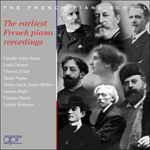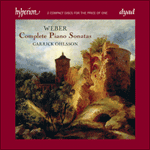
Welcome to Hyperion Records, a British classical label devoted to presenting high-quality recordings of music of all styles and from all periods from the twelfth century to the twenty-first.
Hyperion offers both CDs, and downloads in a number of formats. The site is also available in several languages.
Please use the dropdown buttons to set your preferred options, or use the checkbox to accept the defaults.
from notes by Frank Cooper © 2011
extrait des notes rédigées par Frank Cooper © 2011
Français: Hypérion
aus dem Begleittext von Frank Cooper © 2011
Deutsch: Viola Scheffel
 The earliest French piano recordings The earliest French piano recordingsThis set brings together some of the earliest and rarest piano recordings ever made, not just in France, but worldwide, and includes the complete solo recordings of all the pianists featured except Wurmser. The French office of the Gramophone Comp ...» More |
 Weber: Complete Piano Sonatas Weber: Complete Piano SonatasGarrick Ohlsson is acclaimed for his performances of Brahms and Chopin on Hyperion. These delightful recordings were originally released on Arabesque.» More |

